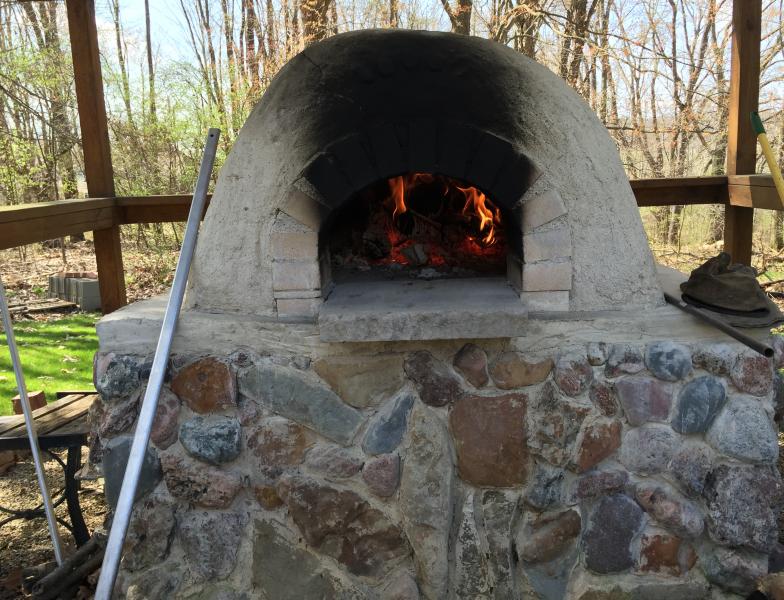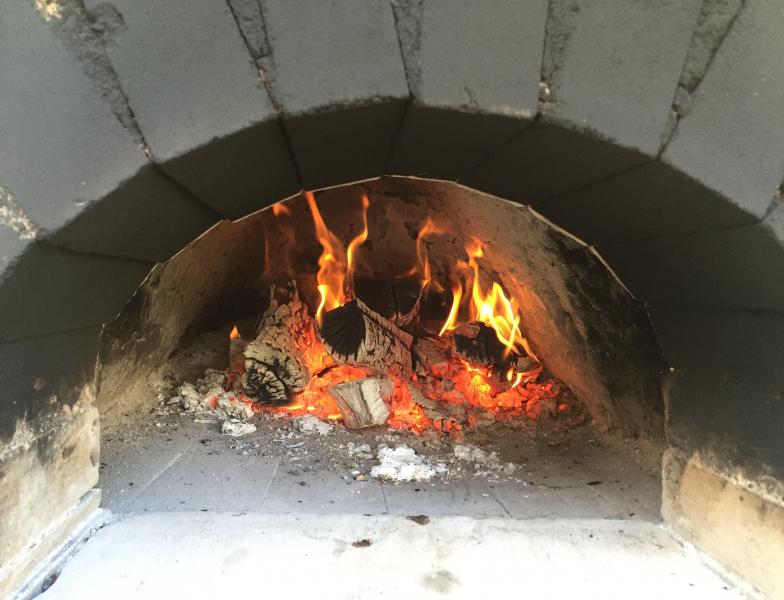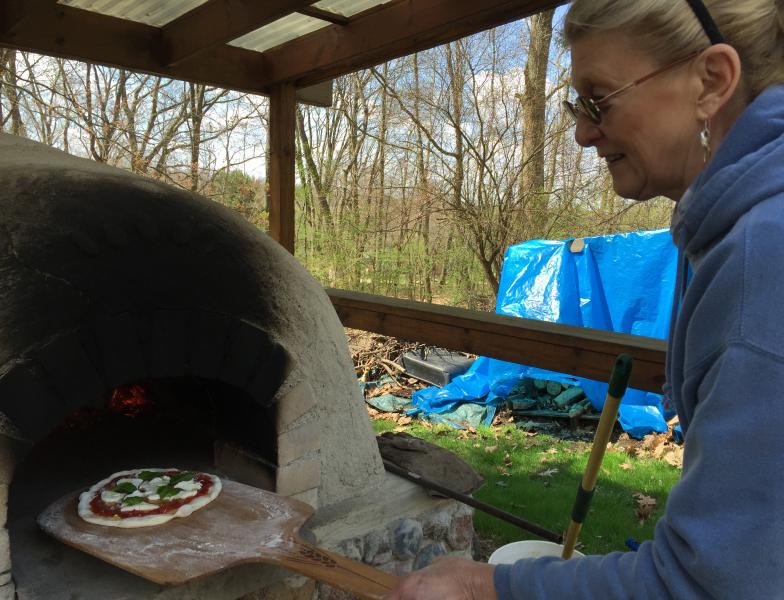Kathy Lehr’s in her Bath backyard getting ready to bake pizza. She’s clearing ash from the floor of the clay oven she constructed, shoveling embers back into the fire and mopping the fire brick floor.
Lehr is one of the region’s most respected artisan bakers. She’s a bread consultant for local restaurants and has taught home cooks how to bake for more than 30 years.
Authentic Napoletano pizza process
Julia Child’s main bread consultant instructed Lehr long ago in the art of the perfect loaf, and more recently experts from Naples, Italy, showed her how to make perfect pizza.
For that, she couldn’t use a regular home oven.
“They don’t heat quite as hot, I mean, some of them will go up to 550.” Lehr needs a lot more heat than that.
When we enter her backyard patio we find it’s nice and warm in front of her oven. Lehr pokes an infra-red thermometer into it.
“See the red dot? You can aim that dot wherever you want. The floor in the front is 750 degrees, and the walls are 936 on the side, and toward the back it’s above 1,000.”
Another hardwood log on the fire
Almost there, but she’ll give it a little more time.
“I think I’m going to load a little bit more wood, and maybe we can get some pizzas going in here.
“What you want to do when you put wood in, you never want to place the wood on the bottom in front of where the air circulates because then it’ll create smoke.”
Lehr’s clay oven sits on a 5-foot-square stone base on her patio. With a dome about 3-feet high she finds it’s big enough for two to four pizzas or 12 to 14 loaves  of bread. of bread.
Cheaper than brick
Lehr had considered buying a brick oven before deciding to build herself a clay one.
“They’re less costly. A brick oven, they can range between $1,200 and $12,000. Building one of these just for the oven itself is about $500.”
Earth ovens are an ancient way of cooking used by primitive peoples around the world for thousands of years. They're newly popular with homesteaders and do-it-your-selfers.
Lehr learned about them from Kiko Denzer, an Oregon sculptor, survivalist and author of "Build Your Own Earth Oven."
Three layers
He showed her how to construct it three layers: the first just sand and clay; the second with wood shavings mixed in for insulation.
“And then the final layer is just a coating to protect it, and that can be done with horse manure.”
She tried that at first but found a lime plaster works best for the final coating.
“You build a sand mold, and then papier mache over the sand mold, and you begin constructing the door and the first layer. Then you do the second layer and the exterior layer, and then as it dries you begin pulling the sand out. the exterior layer, and then as it dries you begin pulling the sand out.
“And then you have to slowly keep firing the oven to get it kiln dried. It takes a while. So this took several firings, and then I was able to get some color in the bread and color in the pizza.”
Good for all kinds of bread
She might use the oven for the Neapolitan specialty pizza Montenera, piercing small circles of dough with a fork before she bakes them, lets them cool, and tops with tomatoes, mozzarella, basil, parmesan cheese and a drizzle of olive oil.
The clay oven fueled with oak, hickory, cherry or any other hardwood is good for many other kinds of loaves, flatbreadsand pitas.
“After the bread is done, I roast chicken in here. I then go into the cycle of slow cook. I could put a cassoulet in there, a slow-cooked roast in there, and leave it for 3 to 4 hours because the temperature’s dropping. And then in the morning  when I wake up, I can actually do muffins because my oven is still 350.” when I wake up, I can actually do muffins because my oven is still 350.”
Convective, conductive and radiant heat
The beauty of the clay oven, she says, is three kinds of heat. You get convective heat from the fire brick at the base, radiant heat from the clay walls, and circulating air creates conductive heat.
“Those three things combined actually produce the best breads and the best pizzas. With pizza in a regular oven you’ll find sometimes when you have the sauce on, and you put the cheese on it, it can stay a little wet in the center. In a wood-fired oven, that does not occur because of the conductive heat, the conductive air moving through it.”
Caution required
There’s no chimney so the hot air comes right out the oven door. Lehr tries not to get too close.
"I’ve singed my hair I don’t know how many times -- and my eyebrows.”
She wears long sleeves for protection, has a sturdy pair of fire gloves and uses long wood and metal peels.
“They tend to slide off of a wood peel much more easily. Then when I’m going
into the oven to rotate it, I use the metal peel to do the rotation.”
Ready to bake
While we’ve been talking the oven’s come up to optimum temperature.
“So our oven floor right where we’re going to bake is around 854 degrees. This is going to be a nice quick bake.”
The dough’s almost ready. All she has to do is stretch it.
“You flip the dough over onto your knuckles. Then I am going
to put it onto the peel. And now we’re ready for the ingredients, and on a Marguerite pizza, you use San Marzano plum tomatoes or a good Italian, and if you notice the color is a deep, deep red.”
Very quick
 The pizza’s transformation is immediate when she lifts the peel into the oven door. The pizza’s transformation is immediate when she lifts the peel into the oven door.
“Do you see how that pizza’s beginning to bubble. And I go in from the left and just keep rotating that pizza around. See how quickly that side has already cooked? The dark on the edges I think is a great thing for pizza. Some people will call it burnt, but I think it adds just a wonderful flavor.
“I’ll cook just a tad over on this side yet. And then the last step is I’m going to raise it to the ceiling.”
The pizza is finished in less than 2 minutes.
It took Kathy Lehr a full week to construct her clay oven.
“And it was 94 degrees when I was building it. So it was a pretty difficult encounter, but I loved every minute of it. I wouldn’t trade this for anything.” |